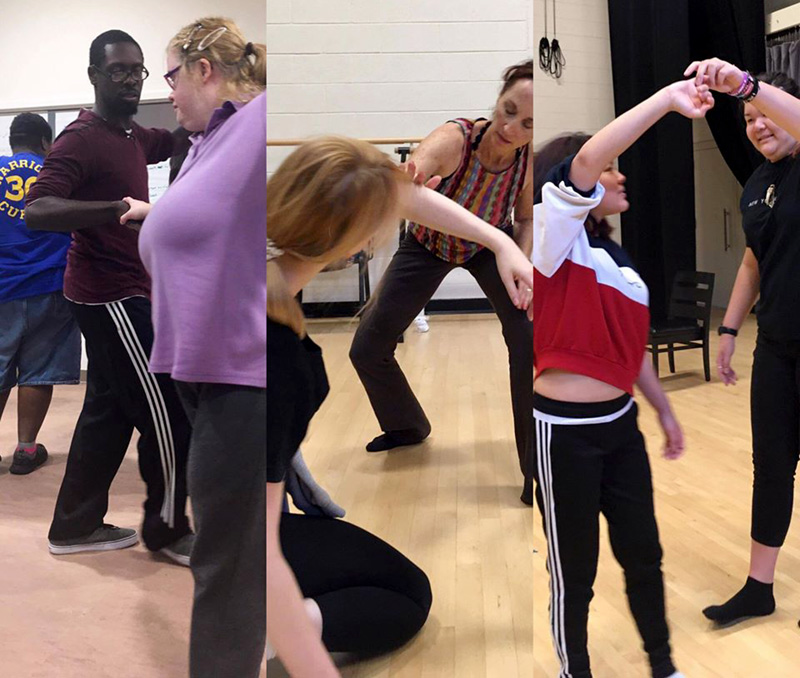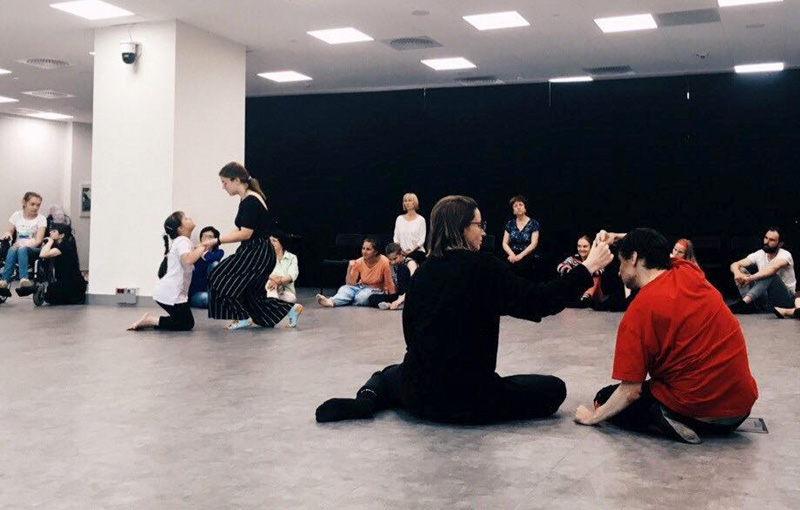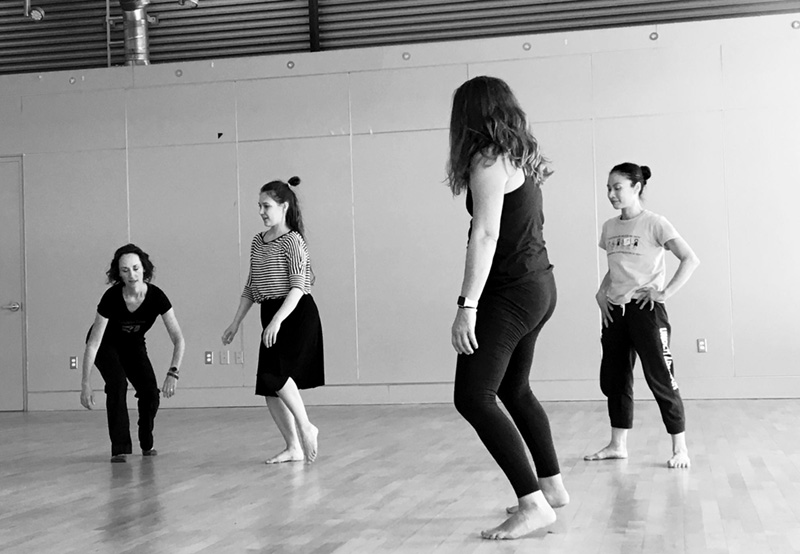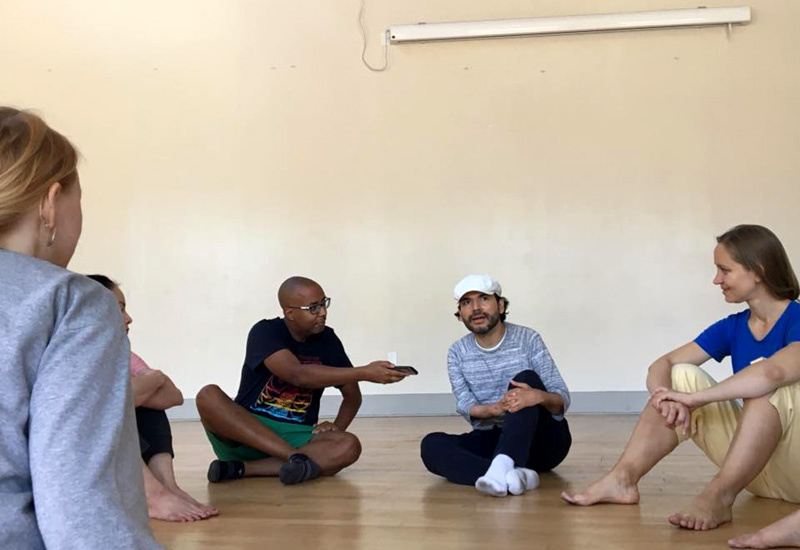Creating New Methodologies for Inclusive Dance
An Interview with Daria Baidina
BY EMMALY WIEDERHOLT
Daria Baidina is a Moscow-based dance artist who recently participated in the Inclusive Dance Lab, a project of BodyWise Dance, which is a dance organization run by Margot Greenlee in Washington DC with a wide range of participatory and inclusive offerings. Here, Daria shares more about what the Inclusive Dance Lab was and what it aimed to accomplish, as well as her own history and experience with inclusive dance in Russia.
~~
Can you tell me a little about your own dance history – what kinds of performance practices and in what contexts shaped who you are today?
I’d never danced before I studied it at university, so I was much older than most when I started to learn dance. I was studying philosophy. This study in philosophy opened me to try something new, which led me to contemporary dance. I studied at a school based in contemporary dance theater, which gave me a good basic understanding of contemporary dance techniques and yoga. Some of the other dancers and I then created an independent contemporary dance company and invited different choreographers to create pieces with us. I also studied a dance language from Batsheva Dance Company in Israel called gaga. This dance language helped me to understand my body and how to move between different textures, as well as how I can surprise myself and enjoy the movement. It had a big impact in my understanding of how I move.
Two or three years ago, the curator of inclusive programs at the Yeltsin Center invited me to lead dance classes for a theater project called ZaZhivoe for people with autism. I started to use my dance improvisation experience with them. It helped me to understand how I can use these practices in the inclusive sphere. This is my specific interest: to bring gaga to what I do now.
How would you describe the dance scene for people with disabilities in Moscow? Do people with disabilities have opportunities to access dance?
We have organizations and grants that offer opportunities for people with disabilities to do dance, but there are not any professional inclusive dance companies like in the US. There are some theater companies who are inclusive. In general, people with disabilities can participate in dance, but it’s usually entertainment dance; there’s music and people dance around. It’s not contemporary. The facilitators of these dance opportunities are educators, not professional choreographers or people with a dance background.
How did you get involved with BodyWise Dance and the Inclusive Dance Lab?
I got an invitation from Elena Vozmishcheva, curator of inclusive programs at the Yeltsin Center in Yekaterinburg, who had a connection with Margot Greenlee, the director of BodyWise. She was looking for dance teachers to participate in the Russian part of the Inclusive Dance Lab. I met with Margot in March at an inclusive theater festival in Moscow, and we had a great time together doing workshops for two days. She knew I was interested in ways to explore inclusive dance based in gaga. That was the beginning of my involvement with the Inclusive Dance Lab.
How would you describe the Inclusive Dance Lab to someone unfamiliar with it?
The project aimed to create new methodology for teaching inclusive dance. We had two parts, one from Russia and another from the US. Each part of the project had different tasks to develop systems to work with people with intellectual and developmental disabilities. In Russia, we worked for three days for about five hours per day in three cities in Russia, testing different ways of using improvisation, choreography, composition and contact improvisation. We found many tools to use for inclusive dance. We also wanted to clarify the language we use to teach inclusive dance in order to make it accessible.
The Russian group came to the US in September to decide what methods worked best. In America, we didn’t have a lot of time to teach, only one or two-hour workshops, so we had to present our material simply. Then we all decided the best tools from what we had presented. It was a good experience to choose a small tool and then create an improvisational structure based on it. We also worked on clarifying the language of presenting the specific tools. When working with people with developmental and intellectual disabilities, it’s important to make language very accessible. If they have to listen for a long time in order to learn how to do an exercise, they start to get bored. We wanted to make sure they really understand the tasks by clarifying the language used.
How was the Inclusive Dance Lab structured?
We had a long research period in Russia to try a variety of inclusive dance methods. Usually we knew who would be participating at our workshops. We had enough time to research many ways to make the material understandable or let the participants help us to search for the best exercises. In the US, we went to different universities, dance companies and arts centers in Washington DC. I didn’t know who would participate in the specific workshops, though some workshops had dancers from Margot’s MVLE Moves Performance Group. In each group, we discussed how we use the tools of creative inclusive dance and why we should practice it. For example, we had conversations about consensual touch. It’s an important question: how do some people know whether they want to be touched or not? This is especially true in contact improvisation. We tried to find tasks for people with intellectual disabilities to understand about consensual touch. At the end of the project, we presented our results and reflected on the impact, as well as brainstormed the next steps for the Inclusive Dance Lab.
From your perspective, what was the impact of the Inclusive Dance Lab?
I learned a lot about how I, as a facilitator, can share leadership. We had a lot of exercises on how a participant can become a leader for the group. I also think that professional dancers and choreographers can learn how inclusive dance is an interesting sphere. It’s not just entertainment. It can be as rigorous as contact improvisation and contemporary dance.
It’s also interesting to think about the concerns of touch. In America, this question is very important. It’s different in Russia. When people to come to a dance class in Russia, they implicitly agree to touch. There’s not an understanding that it can be unwanted. I enjoyed the discussions about this during the Inclusive Dance Lab workshops.
What elements from your experience collaborating on the Inclusive Dance Lab will you take back with you to Moscow?
I’m excited about the discussions on touch and in general having time to discuss issues after class. In Russia, we usually have no discussions, maybe just small feedbacks at the end of classes. Having a big group discussion helps to understand what people need.
What’s next for the Inclusive Dance Lab?
We are compiling a handbook of tasks and tools for inclusive dance, like a menu in a restaurant where you have a starter, an entrée and a dessert. We’ll use this to understand how to say hello to participants, how to do the warm up, and how different improvisations can facilitate communication in the group, as well as how we can create choreography and how the participants can do this by themselves so as to give them leadership.
~~
To learn more about the Inclusive Dance Lab, visit www.bodywisedance.com/inclusive-dance-lab.




